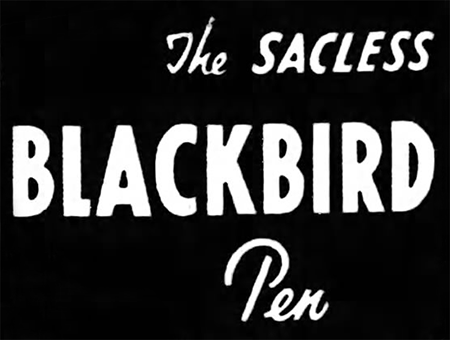Mabie Todd Top Filling Sacless Blackbird 1937-1940
by Jim Mamoulides, November 10, 2023
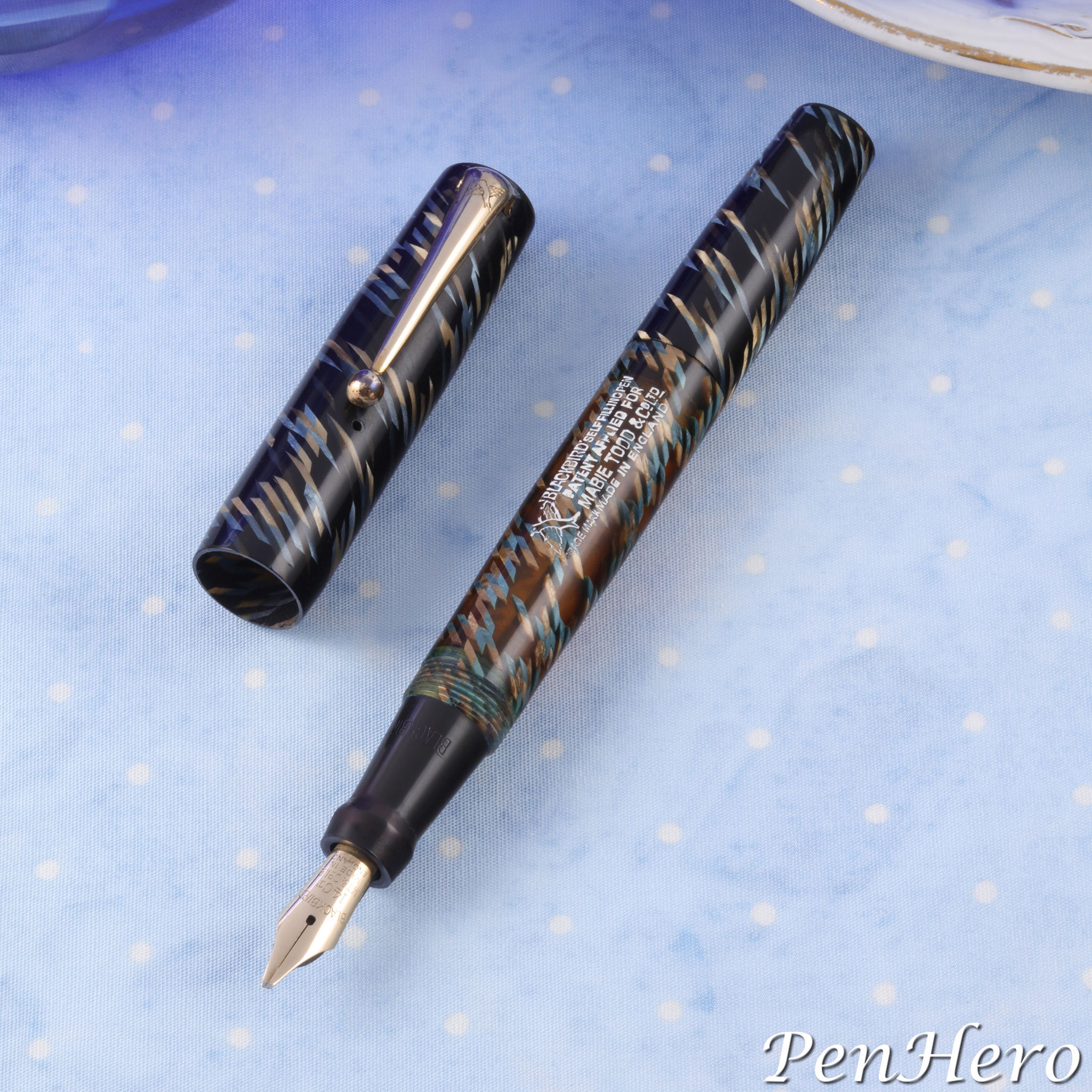 Mabie Todd Blackbird BT200/82 Blue, Gold and Black 1937-1940
Mabie Todd Blackbird BT200/82 Blue, Gold and Black 1937-1940
A Blackbird Plunger Filler With Ink Visible Barrel
When Mabie Todd introduced the Visofil VT series as the replacement for the Swan Visofil V series pens in September 1937, the company also introduced the shorter “top-filling” sacless BT200 Blackbird pen equipped with a very similar plunger filling system. “Top filling” indicates the barrel end is the “top” of the pen when the pen is inverted for filling. Interestingly both the Visofil VT and the Blackbird BT200 were advertised as “sacless” though both use a rubber sleeve in the mechanism that can come into contact with the ink, especially when the pen is pocketed. The earlier Visofil V series also uses a long rubber sleeve, but in that case the sleeve is inside the barrel attached at one end to the section and at the other end to the clear plunger which together comprise the ink container and the filling mechanism includes and is operated by compressing a spring attached to the plunger that surrounds the sleeve. The Visofil V series could hardly be called sacless.
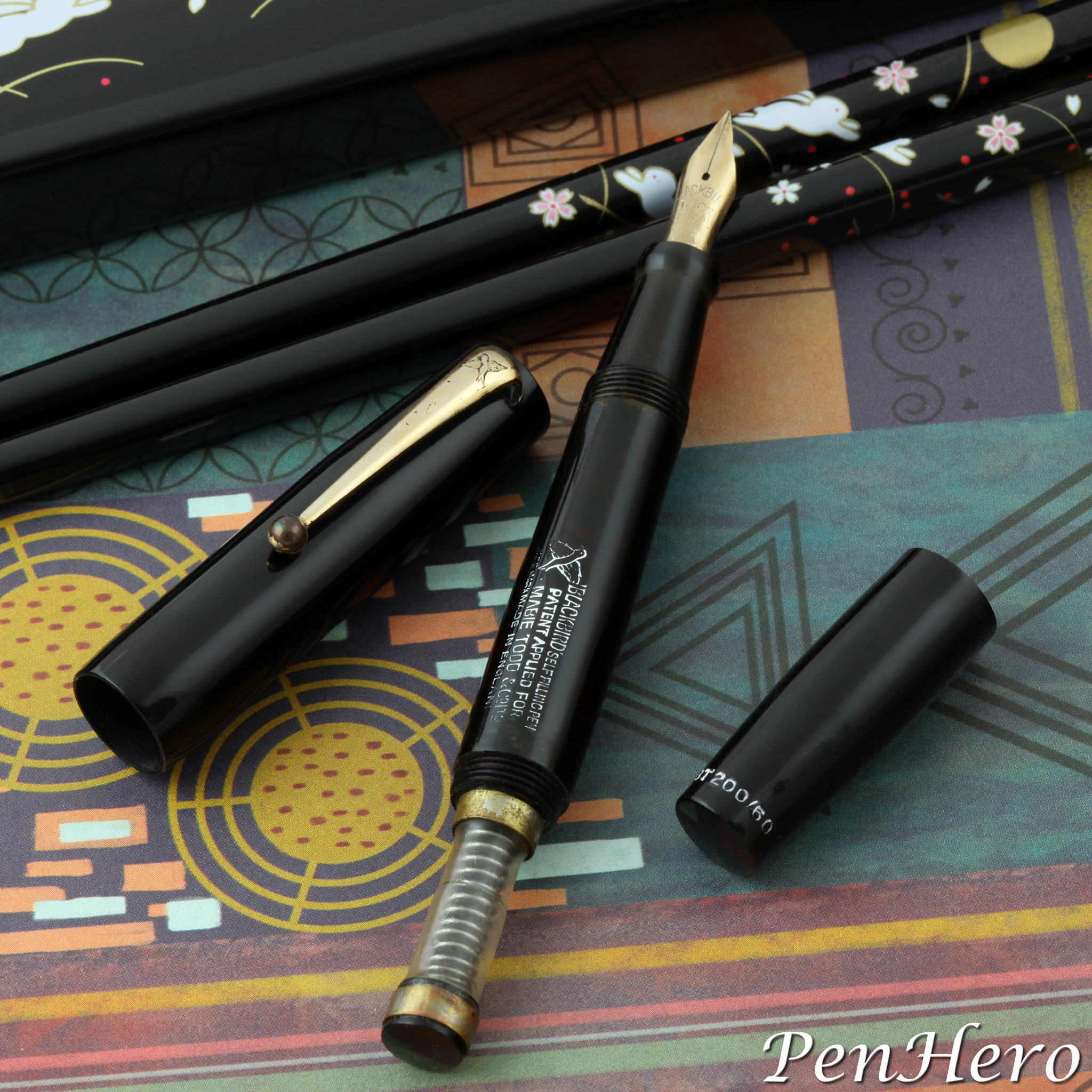 Mabie Todd Blackbird BT200/80 Black and Clear 1937-1940
Mabie Todd Blackbird BT200/80 Black and Clear 1937-1940
The Blackbird BT200 is essentially a simplified version of the Visofil VT and may have appeared earlier. Laurence Oldfield notes, “I would date the Topfiller before the VT on the basis that the mechanism and construction of the filler is virtually identical to that in the earliest VT's - the ones that unscrew in the middle. These VT's are very rare and not immediately distinguishable from the later ones that were cemented together and have an improved mounting for the mechanism.” Both the Blackbird BT200 and Visofil VT pens have plunger-filling spring mechanisms that fill into ink visible barrels making filling and checking ink levels very similar in concept and use.
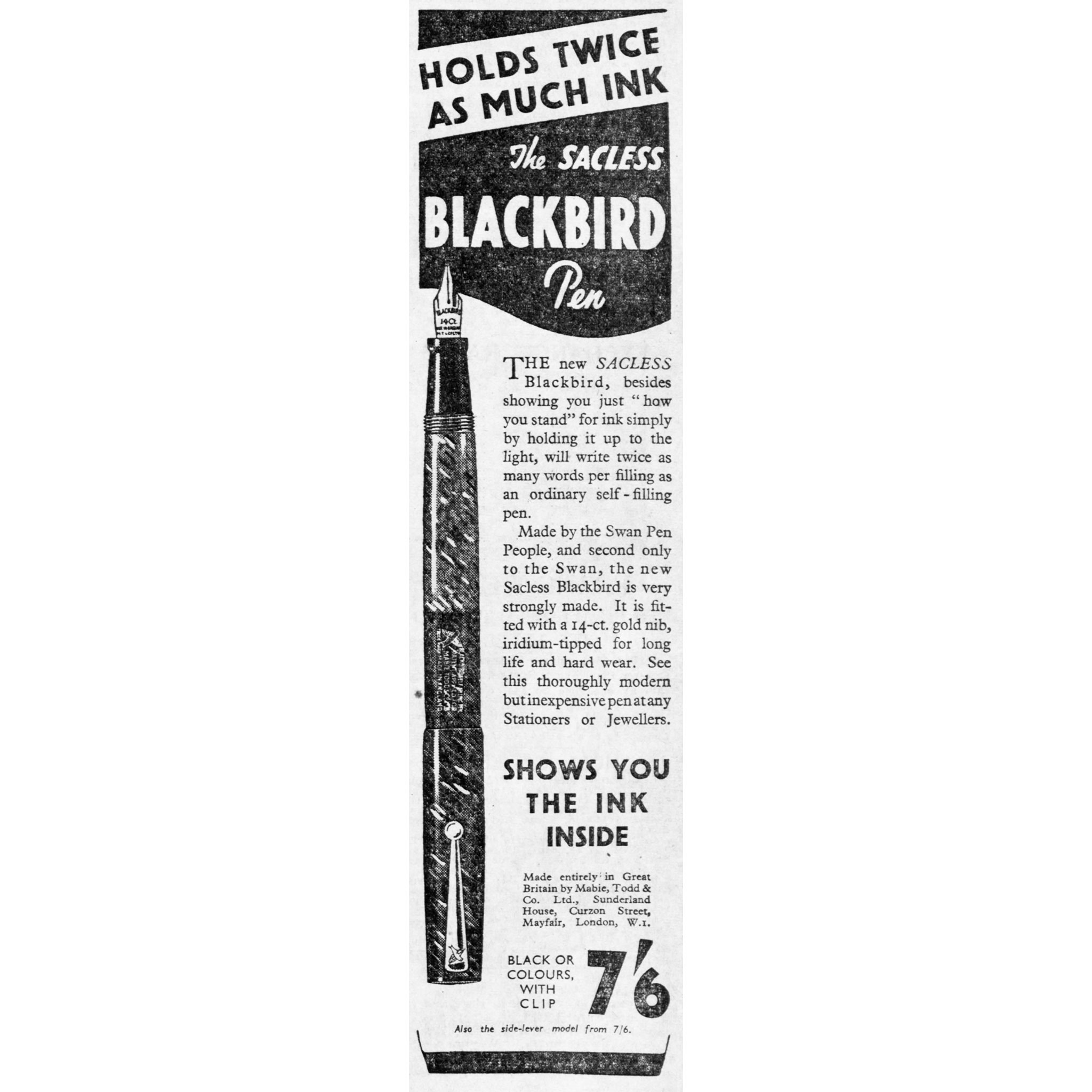 Advertisement, Daily Mail, September 15, 1937
Advertisement, Daily Mail, September 15, 1937
The Blackbird BT200 is shorter, lacks trim rings, the clip attaches through a slot in the cap, and of course has Blackbird markings. The plunger mechanism is very similar in concept but executed differently. In the Visofil VT series pens the plunger must be unscrewed from the base of the barrel, by twisting the attached hard rubber end cap. Fully extended it works by repeated pressing, which compresses a rubber tube or sleeve that acts as a diaphragm, hidden from view inside the opaque bottom half of the barrel. The Blackbird BT200 has a long blind cap that must be removed to operate the filling mechanism, which is fully exposed, showing the rubber tube or sleeve that encloses the spring that surrounds the plunger. At 7/6, or seven shillings and six pence, the Blackbird BT200 was also considerably less expensive than the 25/- priced Visofil VT series, making it an attractive alternative.
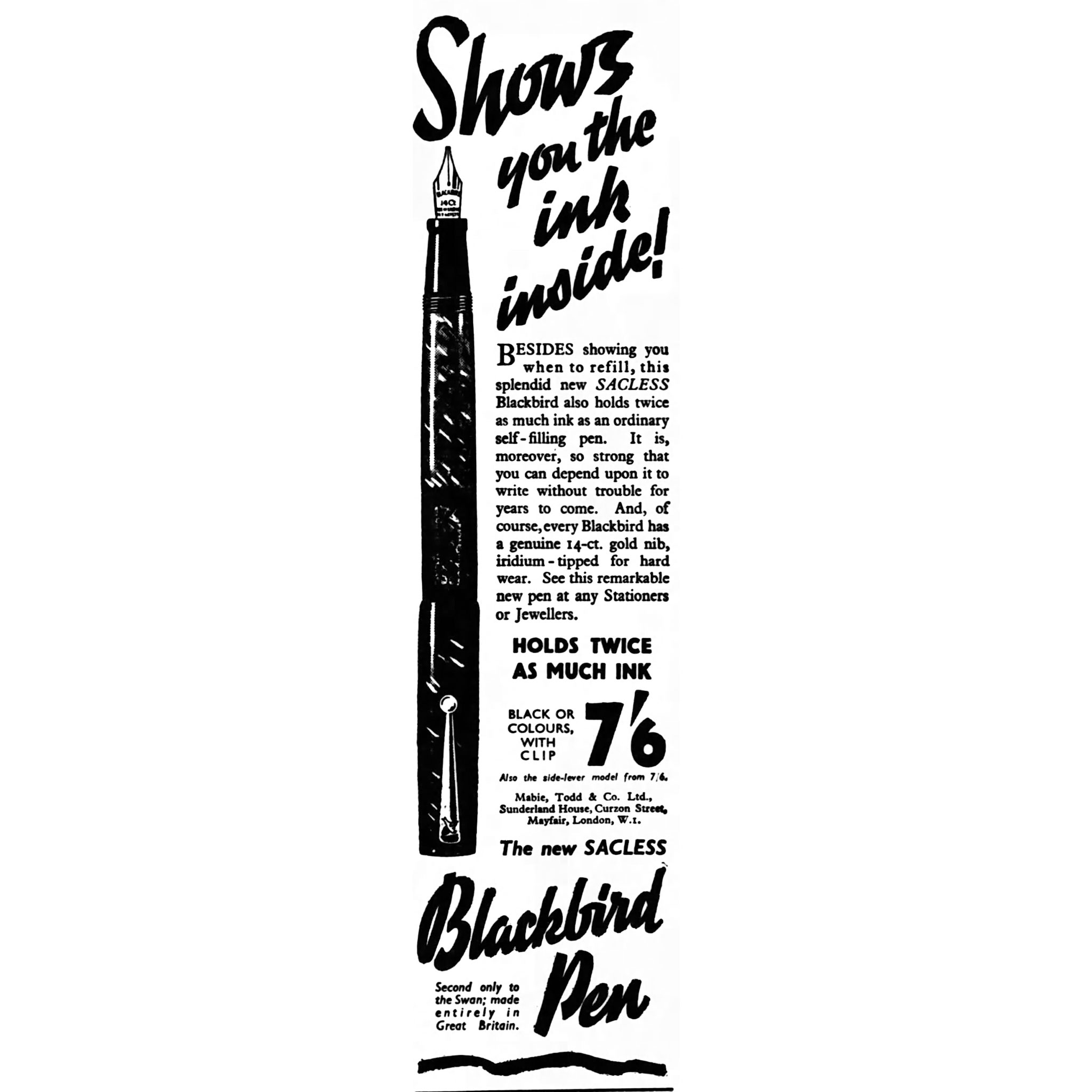 Advertisement, Western Mail, September 7, 1937
Advertisement, Western Mail, September 7, 1937
As with Vacumatic type pens, filling the Blackbird BT200 is done by dipping the nib in ink and pressing the plunger several times to fill the ink chamber in the visible barrel. This is the same basic filling operation as on the Visofil VT except its mechanism is internal.
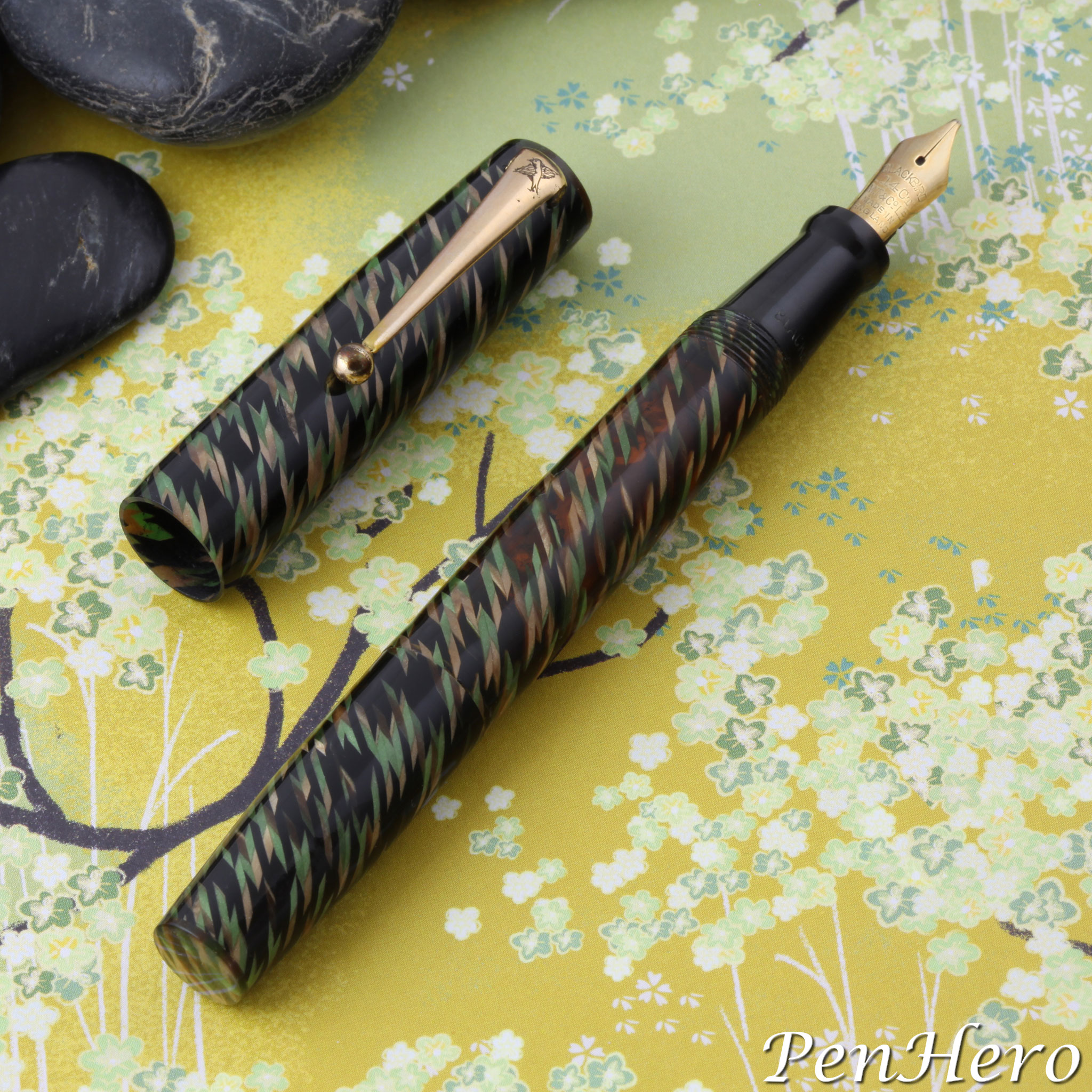 Mabie Todd Blackbird BT200/81 Green, Gold and Black 1937-1940
Mabie Todd Blackbird BT200/81 Green, Gold and Black 1937-1940
According to research done by Steve Hull and Laurence Oldfield, the Blackbird BT200 was offered through 1940, at least until the bombing and destruction of the Mabie Todd Harlesden factory on Barrets Green Road in London, in September 1940. Enough Blackbird BT200s are known to be converted to bulb fillers with ink sacs instead of the plunger mechanisms to raise the question are these pens the result of repairs or were they made originally from proper parts but lacking the plungers.
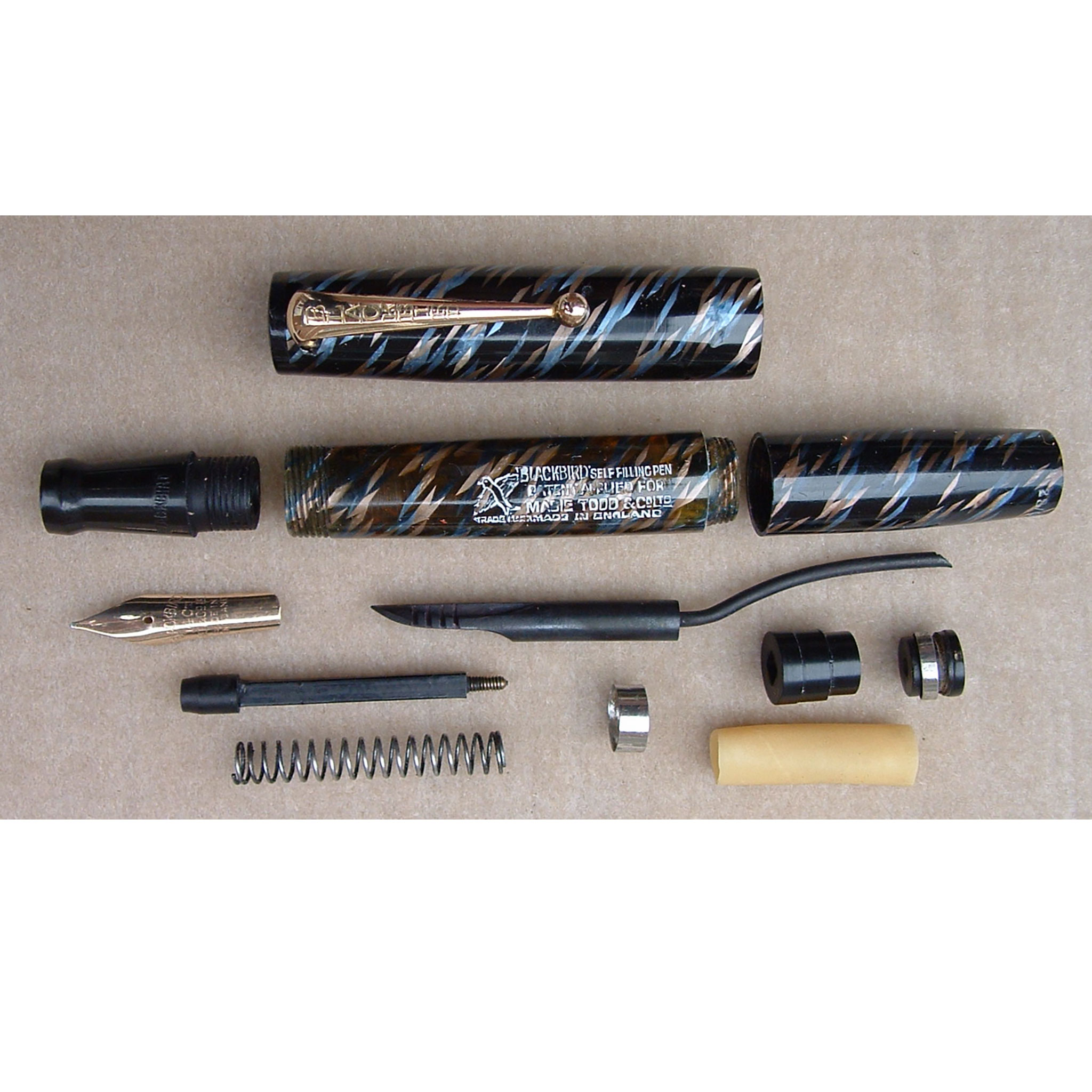 Disassembled Blackbird BT200/82 Blue, Gold and Black – photo courtesy Laurence Oldfield
Disassembled Blackbird BT200/82 Blue, Gold and Black – photo courtesy Laurence Oldfield
Laurence Oldfield, in his article Pen Mechanisms Revealed – 3. The Blackbird Topfillers, from the July 2004 Journal of the Writing Equipment Society (UK) describes three versions of Blackbird BT200 filling systems he has seen in his collecting and repair of these pens. Pens with the original plunger mechanism as described above, a simplified bulb filler that lacks the removable bushing that holds the plunger filling mechanism, and these same simplified pens that have the plunger filling mechanism installed. He believes the latter two versions may have been made after the destruction of the factory in 1940 when Mabie Todd moved assembly operations.
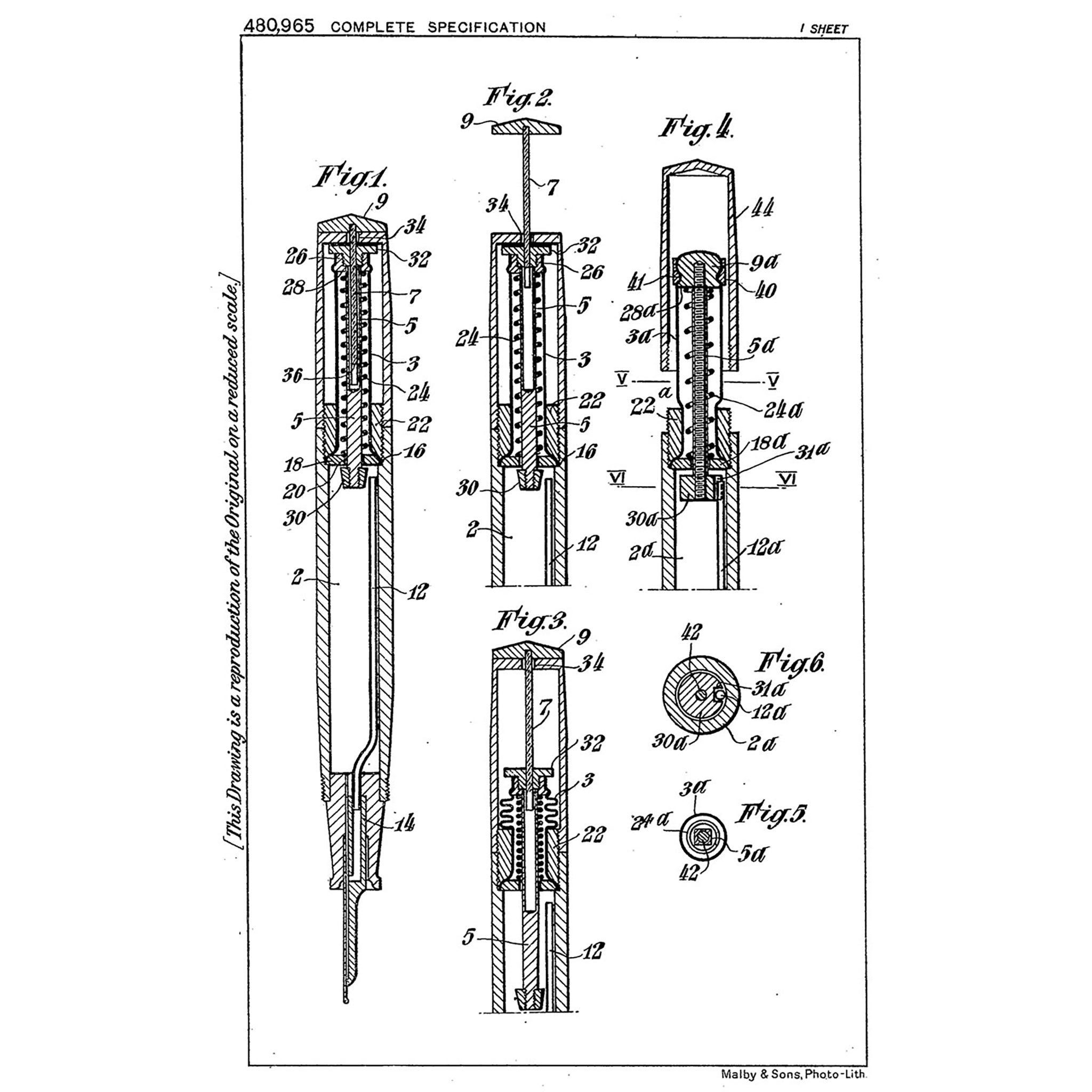 Illustration from the March 3, 1938 Great Britain Patent 480,965
Illustration from the March 3, 1938 Great Britain Patent 480,965
Since the pens are stamped “PATENT APPLIED FOR”, which patent does this refer to? In reviewing Mabie Todd, Leslie William Johnson, and Edward Stephen Sears’s Great Britain Patent No. 480965 and Patent No. 514513 it appears that the Blackbird BT200’s filling mechanism is based on Patent No. 480965, and specifically Figure 4 in the patent, showing the plunger mechanism under a blind cap rather than extending by unscrewing the end of the barrel as on the Visofil VT series. Patent No. 514513 takes this design a step further by describing a pen that fills by a nipple or ink passage at the end opposite the nib to avoid, as the patent says, blobbing, wiping the nib, and damaging the nib when bottle filling, and shows several variations of that concept.
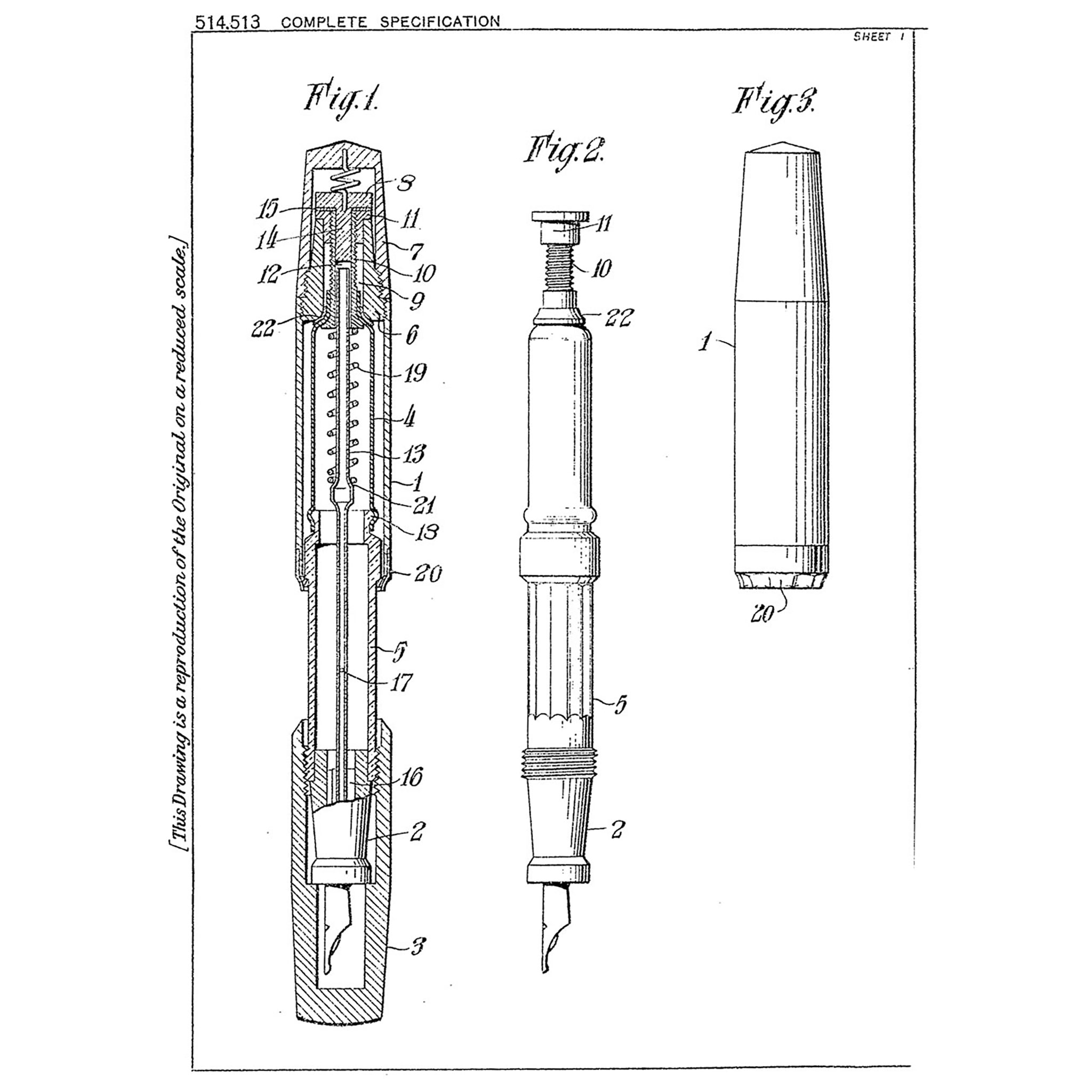 Illustration from the November 10, 1939 Great Britain Patent 514,513
Illustration from the November 10, 1939 Great Britain Patent 514,513
Blackbird Model BT200 Identification Guide and Features
The Blackbird BT200 sold for 7/6 and came only in one size and trim style. It’s about 4 3/4 inches long capped and 6 inches posted. Pens vary only in choice of color. Matching Fyne Poynt semi-automatic pencils were available for 5/6.
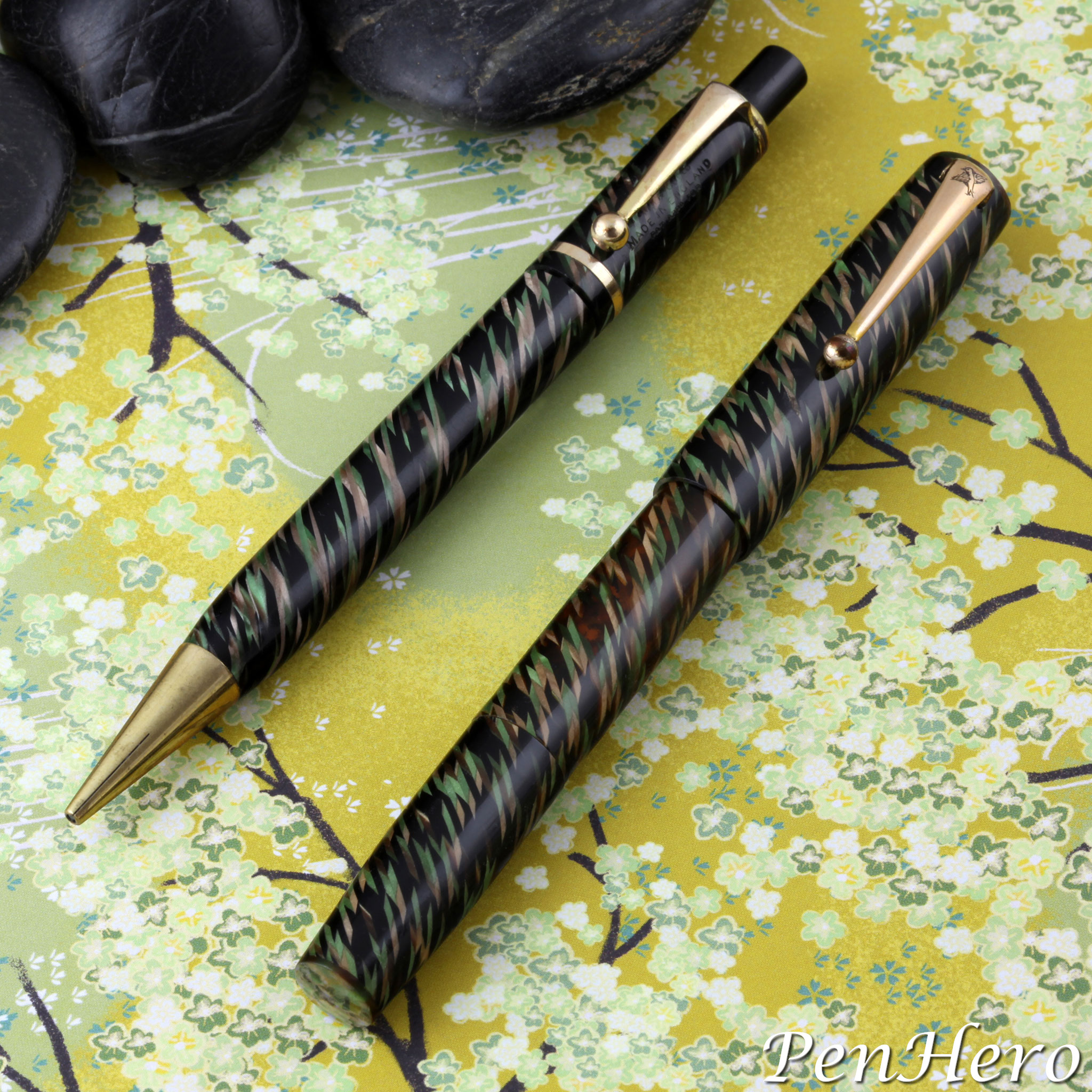 Mabie Todd Blackbird BT200/81 Green, Gold and Black 1937-1940 with matching Fyne Poynt pencil
Mabie Todd Blackbird BT200/81 Green, Gold and Black 1937-1940 with matching Fyne Poynt pencil
Pens stamped Le Merle Blanc as part of the manufacturer’s imprint on the barrel were, according to Steve Hull, “marketed in Belgium (and probably France and Switzerland), where Mabie Todd had their own sales company in Brussels since c. 1920.”
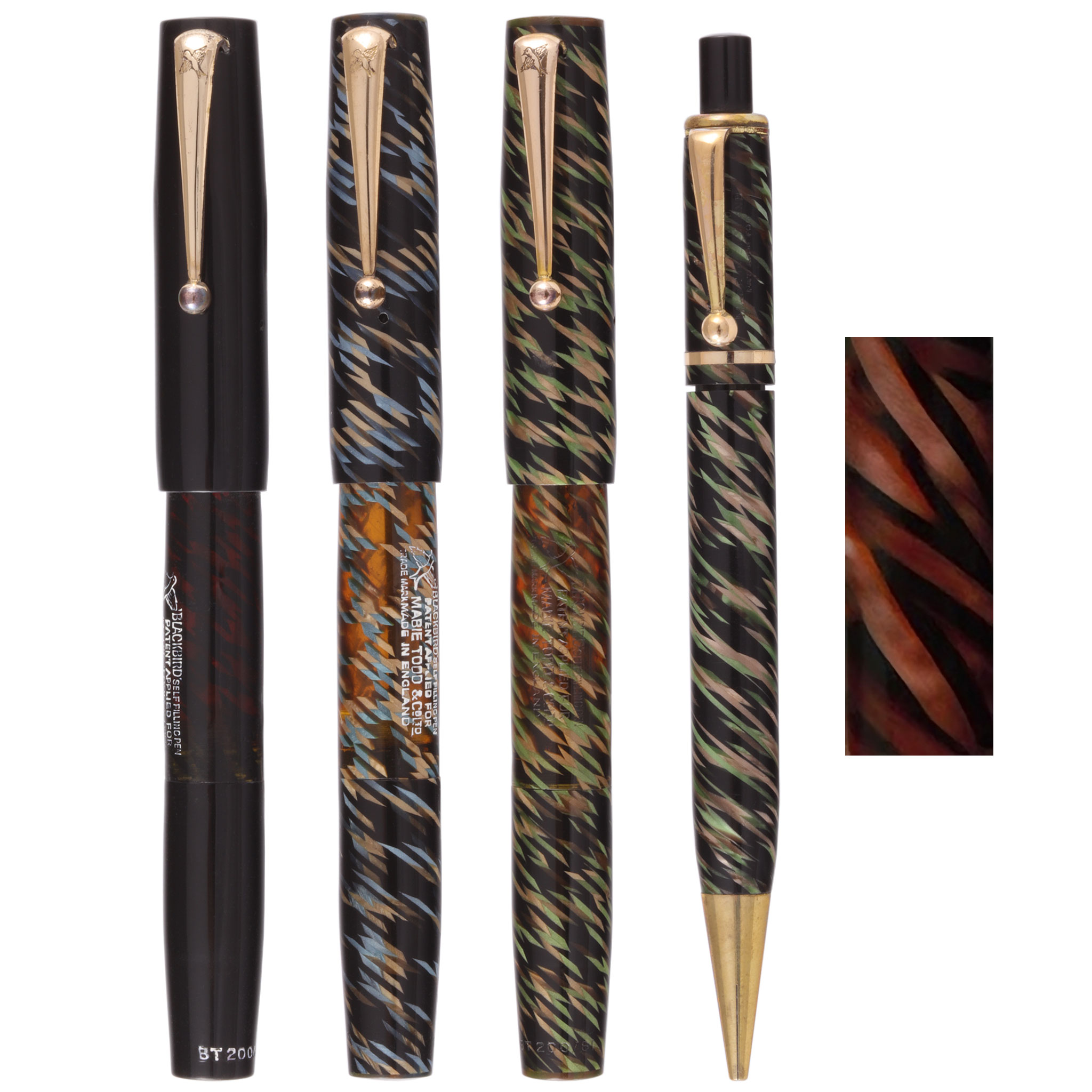 Mabie Todd Blackbird pens with Fyne Poynt pencil and color swatch from uncataloged pen
Mabie Todd Blackbird pens with Fyne Poynt pencil and color swatch from uncataloged pen
There is one additional cap and barrel color known but not catalogued and is not on the list below. The color swatch can be seen above.
- Celluloid cap and barrel in the following colors, shown by the Mabie Todd color number and name: /80 (also /60) Black and Clear, /81 Green, Gold and Black, and /82 Blue, Gold and Black—a Black and Clear pen would be model BT200/80
- Cap and barrel end are matching opaque celluloid, barrel center is transparent patterned celluloid
- Ball end washer clip with either the Blackbird logo stamped at top or BLACKBIRD stamped down the face. Catalogs and advertisements show the Blackbird logo clip
- Conventional 14 karat gold nib, stamped: BLACKBIRD over 14CT over MT & CO LD over MADE IN over ENGLAND
- Nib grades included extra-fine, fine, medium, broad, and oblique, in firm and flexible
- Blackbird Self Filling Pen imprint, with the Blackbird logo and trademark, appears on the translucent part of the barrel as BLACKBIRD SELF FILLING PEN over PATENT APPLIED FOR over MABIE TODD & CO LTD over MADE IN ENGLAND
- Pen model will be stamped near the end of the blind cap, such as BT200/60
- About 4 3/4 inches long capped and 6 inches posted
- Black section stamped "BLACKBIRD"
- Retail price for the pen was 7/6 for the pen, 5/6 for the pencil
Performance
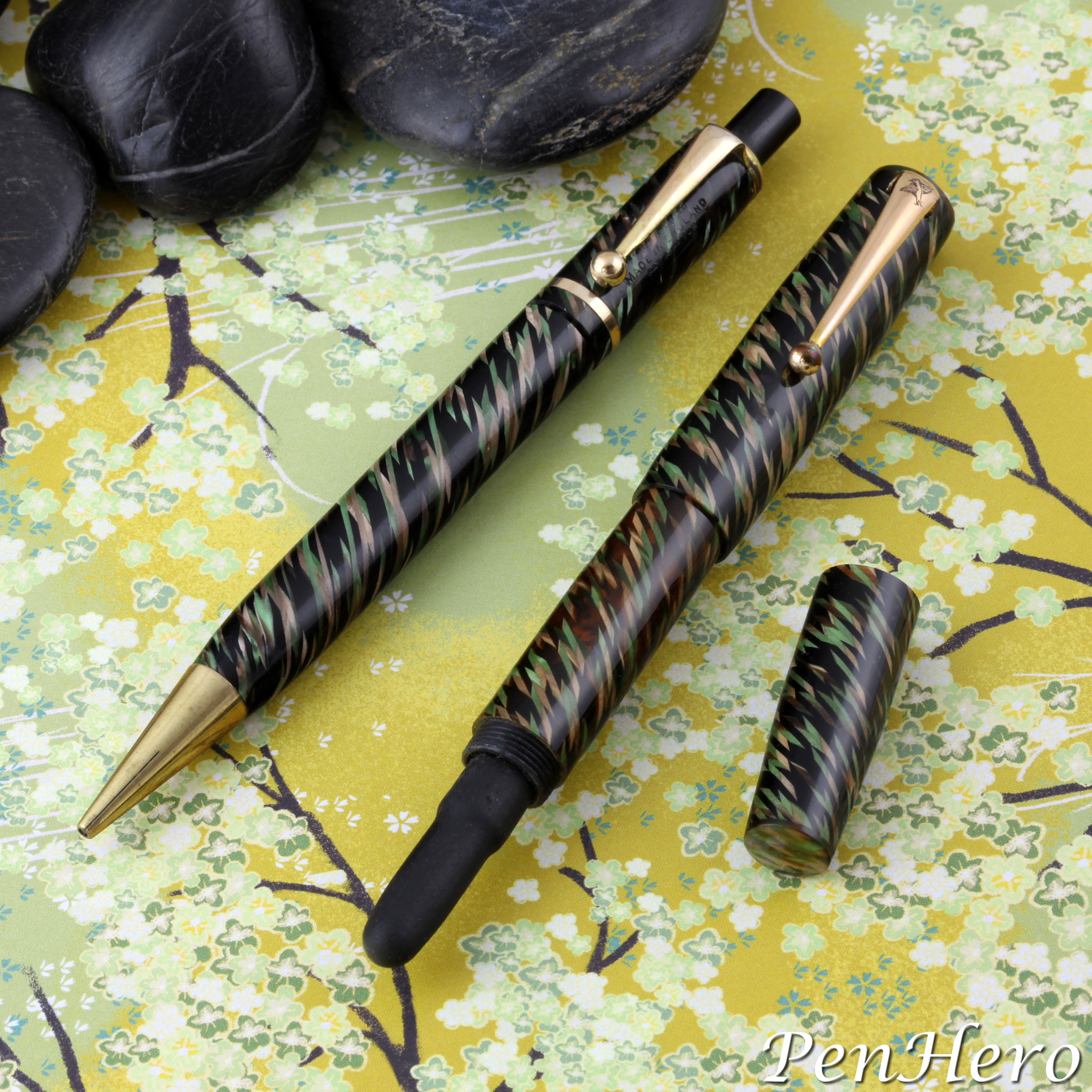 Mabie Todd Blackbird BT200/81 Green, Gold and Black 1937-1940 with matching Fyne Poynt pencil
Mabie Todd Blackbird BT200/81 Green, Gold and Black 1937-1940 with matching Fyne Poynt pencil
In my experience, Blackbird BT200 Top Fillers are the most difficult of the Mabie Todd plunger fill pens to find, especially with the plunger mechanism intact. Some have been converted to bulb fillers possibly for lack of parts during World War II, made that way originally, or as later repairs done without familiarity with the mechanism. Being a challenge to service leaves many complete pens unusable. Finding a fully serviced and working Blackbird BT200 is a real treat as they are very beautiful pens.
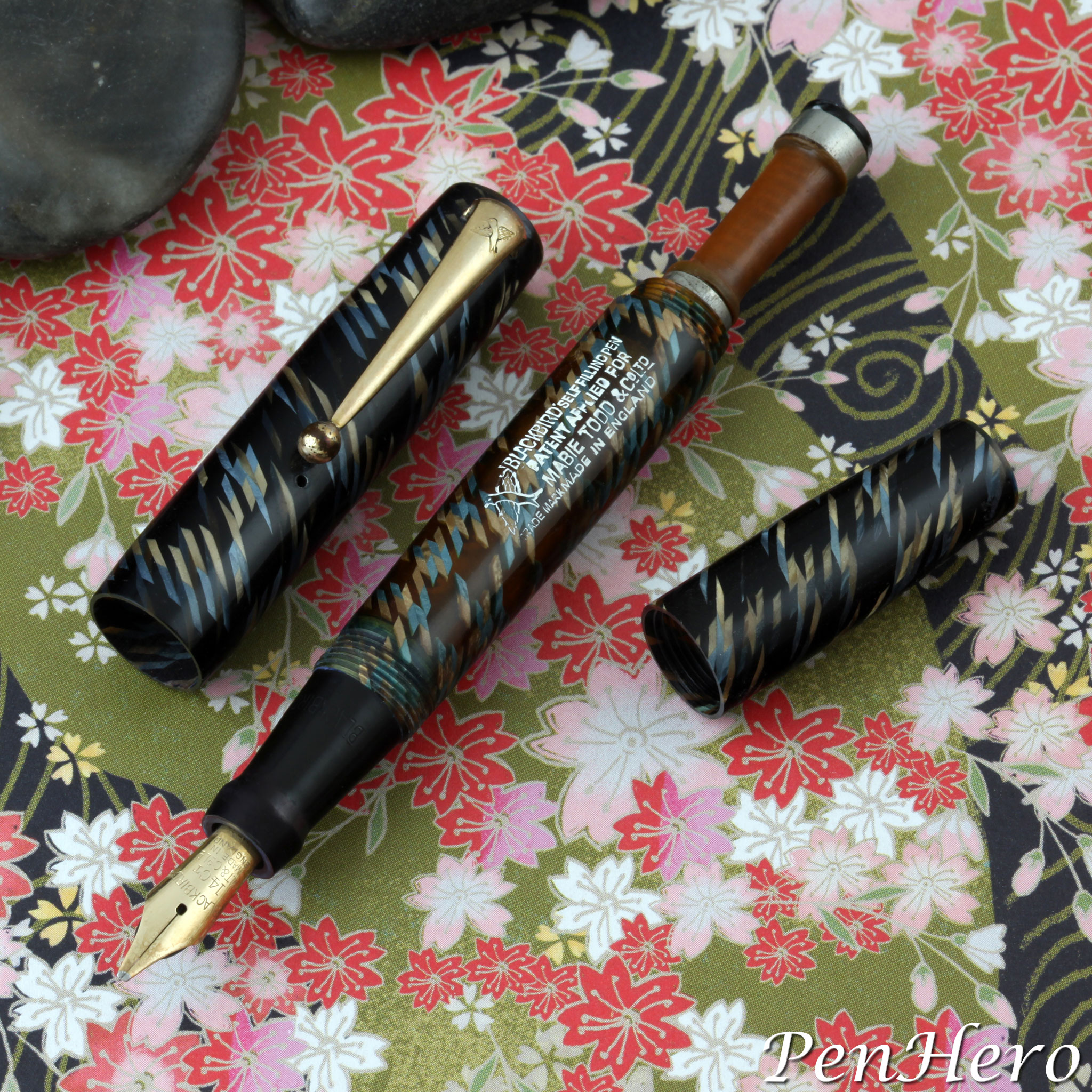 Mabie Todd Blackbird BT200/82 Blue, Gold and Black 1937-1940
Mabie Todd Blackbird BT200/82 Blue, Gold and Black 1937-1940
The Blackbird BT200 Top Filler is visually more like the Visofil V Series than the VT and sits fairly low in the pocket due to the clip being positioned high on the cap. I don’t find the caps post very securely on the barrel end, so I write with them unposted. In my experience the nibs show typical Mabie Todd writing quality, and some are soft and expressive writers.
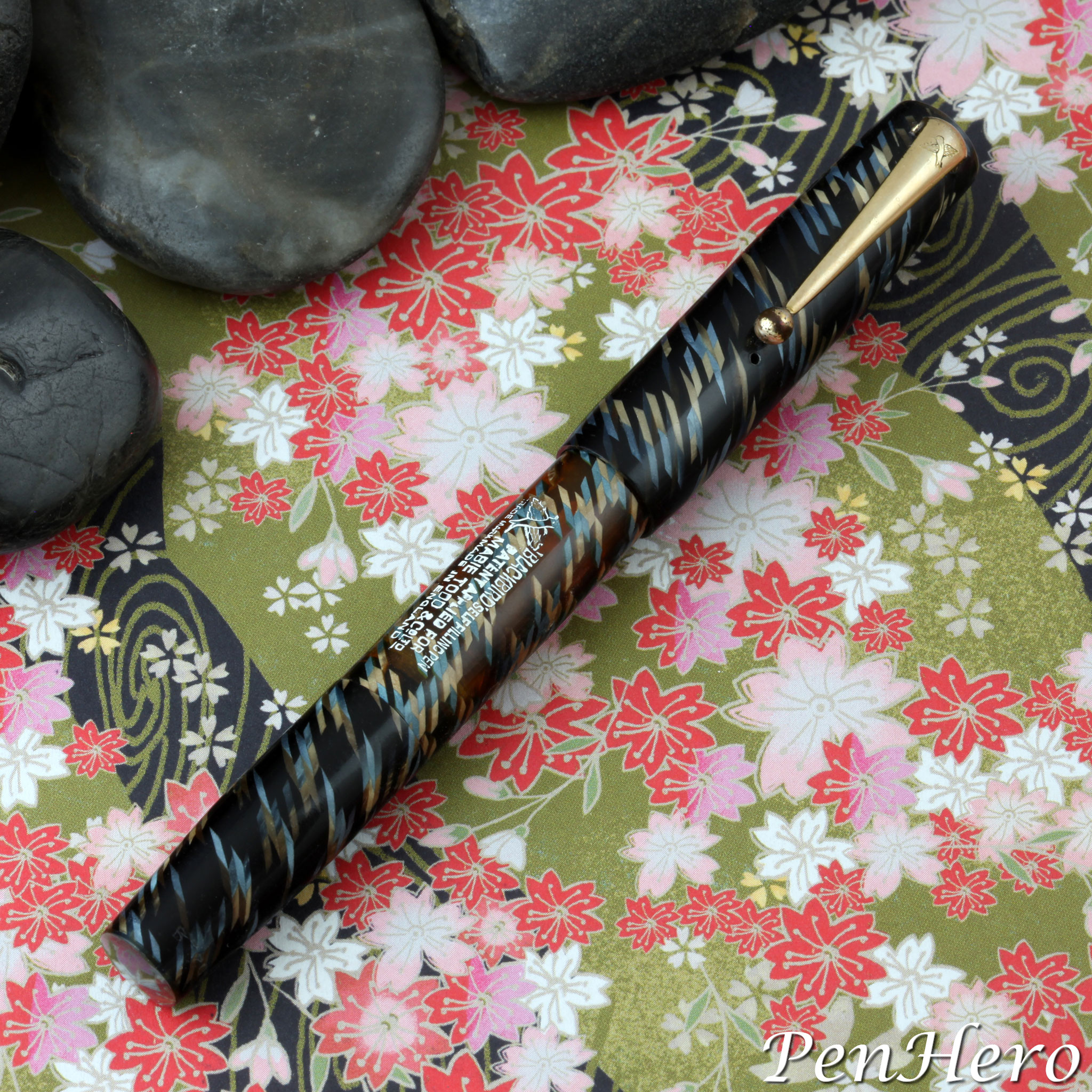 Mabie Todd Blackbird BT200/82 Blue, Gold and Black 1937-1940
Mabie Todd Blackbird BT200/82 Blue, Gold and Black 1937-1940
These are special pens and belong in a collection with their Visofil peers. They have gorgeous celluloids and very interesting filling systems, not to mention exceptional nibs.
Acknowledgements
Warmest thanks to Laurence Oldfield. A great deal of the information used to update this article, especially technical details, and model information, is from his article “Pen Mechanisms Revealed—1. The Swan Visofil,” originally published in the Journal of the Writing Equipment Society (UK), November 2002, and is used with the permission of the author. Dr. Oldfield repairs Visofils and can be contacted at his website, penpractice.com.
Also, many thanks to Steve Hull who supplied the color identification and detail information about the different models of the Blackbird BT200 pens from his work on Mabie Todd pens, The Swan Pen, Mabie Todd in England 1880–1960, which has been available since 2019. The book has 400 full-color pages and includes images of the Blackbird BT200 pen and pencil range. It can be obtained at englishpenbooks.co.uk.
Image of the rust red celluloid BT200 was created referencing “old fountain pens just for fun” by Luiz Leite
Pennant Spring 2023
This story appeared in the spring 2023 Pennant, the magazine of the Pen Collectors of America (PCA). You can learn more about joining the PCA and subscribing to the Pennant by clicking the link.
References
Advertisement, Daily Mail, September 15, 1937, page 5
Advertisement, Kensington Post, Middlesex Independent and West London Star, June 8, 1940, Page 4
Advertisement, The Age, December 15, 1938, page 16
Advertisement, The Sydney Morning Herald, December 20, 1939, page 6
Advertisement, Western Mail, September 7, 1937, page 5
Great Britain Patent Specification 480,965, awarded March 3, 1938
Great Britain Patent Specification 514,513, awarded November 10, 1939
Works by Laurence Oldfield:
“Fountain pen filling systems and ink capacity limits,” Journal of the Writing Equipment Society (UK), Winter 2020.
“Pen Mechanisms Revealed—1. The Swan Visofil,” Journal of the Writing Equipment Society (UK), November 2002.
“Pen Mechanisms Revealed—3. The Blackbird Topfillers, Journal of the Writing Equipment Society (UK), July 2004.
“The development of ink visible ‘diaphragm’ filling pens,” Journal of the Writing Equipment Society (UK), July 2011.
The Swan Visofil VT Pen: The Pen Practice Manual for Servicing and Repair, Undated.
Interact
Comments on this article may be sent to the author, Jim Mamoulides


